Not only are fermented vegetables delicious, they are also rich in probiotics. Learn how to ferment nearly any vegetable and check out some of our favorite fermented veggie recipes at the farmhouse.
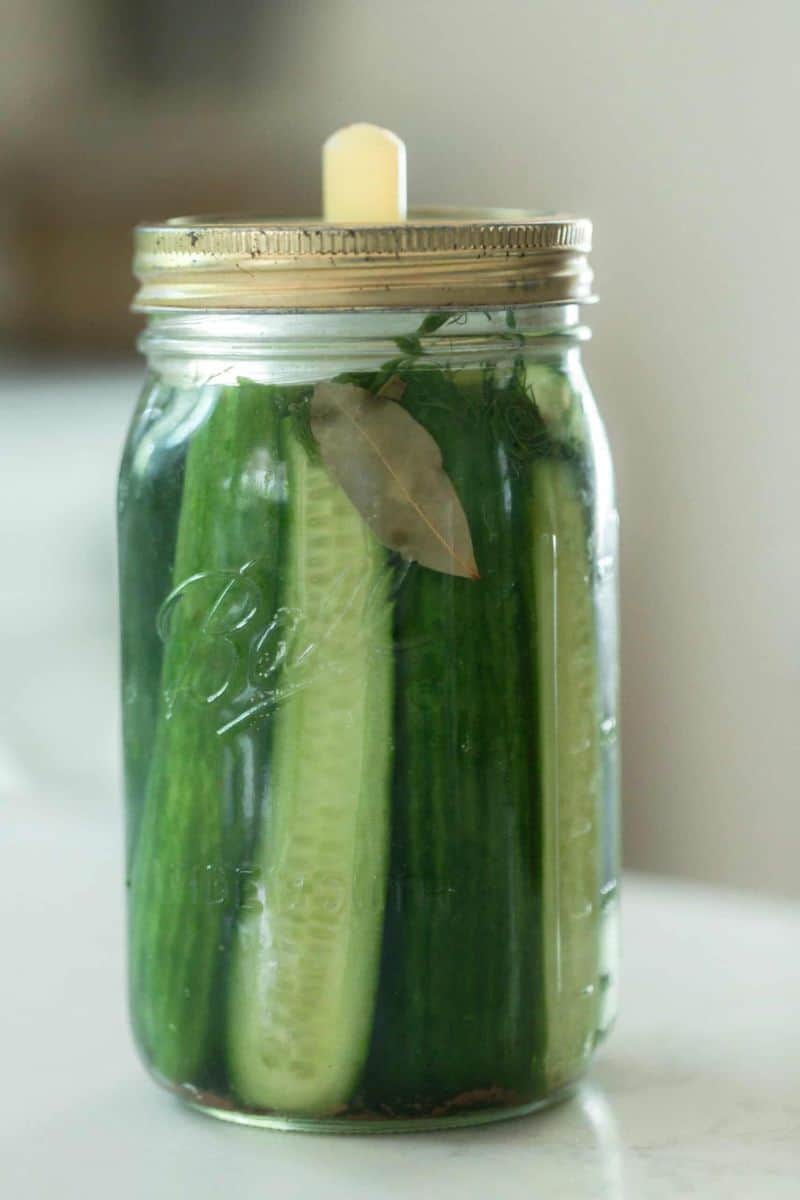
This post contains affiliate links, which means I make a small commission at no extra cost to you. See my full affiliate link disclosure here.
You’ll hear me talk about fermented foods quite frequently here, and for good reason. If there is ever such a “health food”, it should be this.
When you think of fermented foods, the first thing that may come to mind is dairy products, such as milk kefir or yogurt.
But the same lacto-fermentation process these dairy products undergo, can be utilized with vegetables. (You can also ferment fruits, too! Learn how to make your own fermented fruits here.)
Lacto-fermentation takes beneficial bacteria that are naturally occurring on vegetables and converts them to lactic acid. And what does that lactic acid bacteria give you? Probiotics!
Why You’ll Love Fermented Vegetables
The health benefits – Lacto-fermentation increases the vitamin and enzyme levels, and improves the digestibility of the fermented food. The gut-healthy probiotics it produces also come with a plethora of health benefits, including helping the immune system, decreasing inflammation, and helping decrease the incidence of certain diseases like heart disease. (source)
Longer storage – Before there was modern day canning, people needed a way to preserve their food to last longer. Lacto-fermentation does just that. Basically, you are allowing the good bacteria (lactobacillus) that is already present on vegetables to take over while salt inhibits the bad bacteria. Fermented vegetables that are properly prepared and stored in a cool, dark place (like the refrigerator) can last at least 4-18 months.
The tangy taste – Not only is it healthy and a great way to preserve summer produce, it also gives you a delicious, tangy taste. The longer it ferments, the tangier it will be.
Ingredients

Vegetable of choice – Most any vegetable can be fermented. Some of my favorites are carrots, garlic, and beets. I’ve included a roundup of my favorite recipes below. You can even add fresh herbs to your ferments for more flavor.
Salt – I prefer a good quality sea salt.
Water – All fermented vegetables require a salt brine. But not all fermented veggies require water to do this. Homemade sauerkraut and homemade fermented salsa, for example, create a brine of their own from their juices just by adding salt. For veggies that do require water, like carrots and garlic, be sure to use filtered water.
Tools You May Need
Fermentation lids – While you can use a tea towel and rubber band, these lids are great if you plan to do a lot of fermenting.
Fermentation weights – You can get creative here. I know some people who use a rock in a Ziplock bag. If you ferment often though, I love these glass fermentation weights.
Glass Jar – You can use any size of wide mouth jar. Since we have a big family and go through a lot of ferments, I usually use 1/2 gallon mason jars.
7 Fermented Vegetable Recipes
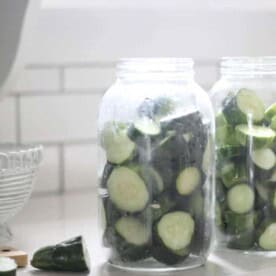
Homemade Fermented Pickles
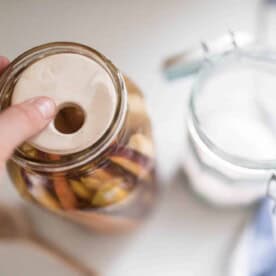
Fermented Carrots
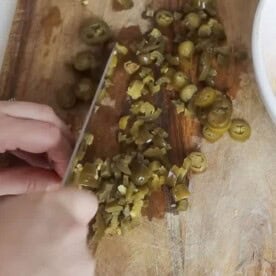
How To Make Fermented Jalapeños

Lacto-Fermented Garlic
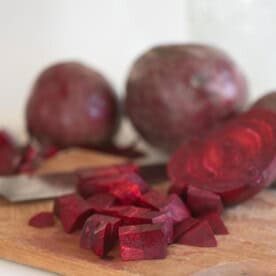
Fermented Beets
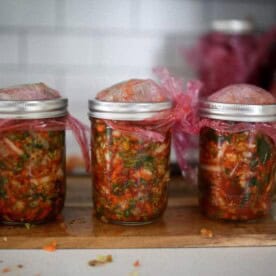
Fermented Homemade Kimchi
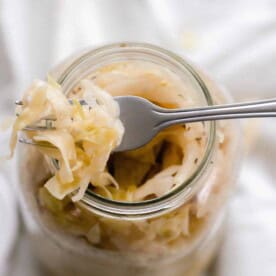
How To Make Sauerkraut
Fermented Veggies FAQ’s
Nearly any vegetable can be fermented. Some of the best vegetables include carrots, cabbage, cauliflower, garlic, and beets. Even green beans can be fermented!
Pickling utilizes an acid and sometimes heat in order to create that classic pickled flavor. Fermentation does not require an acid or heat. Unlike pickled veggies, fermented vegetables provide gut-healthy probiotics.
The “lacto” portion of lactose fermentation refers to Lactobacillus, a species of beneficial bacteria which are present on the surface of all plants. This beneficial bacteria converts lactose or other sugars into lactic acid.
Basically, you are allowing the good bacteria (lactobacillus) that is already present on vegetables to take over while salt inhibits the bad bacteria. The good bacteria then grow with a little time at room temperature.
Depending on the type of food you are fermenting, it will take a few days to a few months. Follow recommendations on specific recipes. Once the process is complete, you typically store the foods in the refrigerator to slow down the fermentation process.
Fermented foods that are properly prepared and stored in a cool, dark place (like the refrigerator) can last at least 4-18 months.
Always look for any signs of mold, an even color throughout, and make sure it still looks edible. Use your nose to see if it still smells as it should, and doesn’t have a bad smell. Check to make sure the texture is still good, and not mushy. You can always taste it to make sure it tastes good.
More Fermented Recipes From the Farmhouse
- Homemade Fermented Ketchup
- Fermented Hot Sauce
- Fermented Balsamic Blueberry Vinaigrette
- Water Kefir
- Berry Kefir Smoothie
If you try any of these recipes and love them, I would love it if you could come back and give them 5 stars! Tag me on Instagram @farmhouseonboone.










So glad you are sharing this information. I tried do cherry tomatoes last year,but was like you the first time…worried I did it wrong and throw them out:( I am going to follow your directions and try again! Thank you!
thank you for taking the time to teach others about fermentation. it will take me time to read everything you are the best.
Lisa, a wonderfully written informative post. I am in awe of all you do and share. Thanks much
Hi Lisa Greetings from Singapore! Your blog has inspired me to ferment my own vegetables and have started the process a couple of months ago. I have a quick questions regarding fermentation. After a week or 2 of fermentation in salt water, can I transfer these veg into a solution of rice vinegar and alittle of sugar? My family and I kinda like the sharpness of the vinegar as well as a tinge of sweetness. Looking forward to hearing from you!
Vinegar will kill the bacteria rendering this entire process worthless, unfortunately. You will find that lactofermented veggies have a very similar tang to vinegar brined “pickled” veggies. You probably won’t have any desire to add vinegar.
How much salt should I add per a cup? I didn’t start yet because I so confused from salt amounts
Thank you for your helpful info on fermentation. I’m learning a lot of good and useful tips.
When putting the fermented vegetables in long term storage in a cool dark place, do you remove the weight first or leave it in the jar?
Thanks, wendy
Yes! I remove the weight and add an airtight lid.
Thank you!!
Hi Lisa, thanks so much for sharing…love cucumbers and carrots and want to start with the carrots…Again, thank you again for freely sharing your hearts passion with us.
Lisa, do you have a fermentation recipe for natto?
Do you have a preference on the salt? I love your blog and your YouTube channel.
Question, does fermenting mean there’s also alcohol in the foods then?
Yes, in small amounts!
Would you kindly share the information about the baby carrier that you are wearing? Thanks so much! Jill